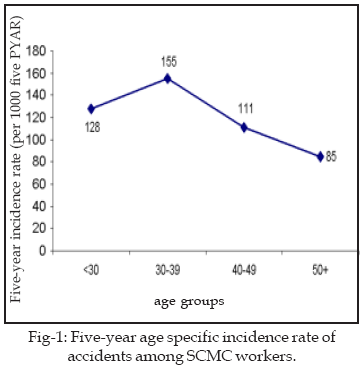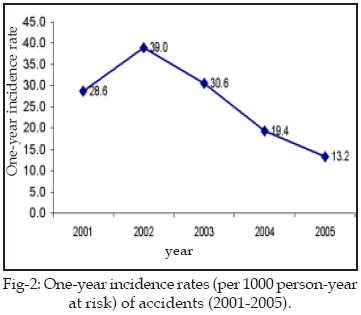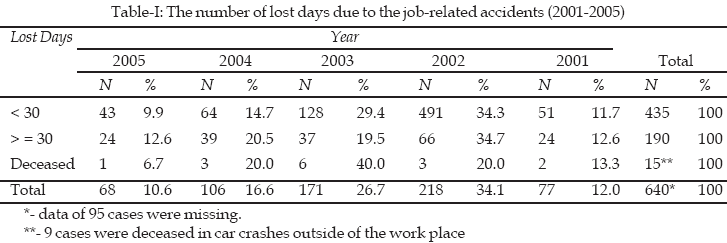|
|
||||
|
Published by : PROFESSIONAL MEDICAL PUBLICATIONS |
||||
|
ISSN 1681-715X |
||||
|
||||
|
- |
||||
|
ORIGINAL ARTICLE |
||||
|
- |
||||
|
Volume 25 |
April - June 2009 (Part-II) |
Number 3 |
||
|
|
||||
|
||||
|
|
||||
|
Published by : PROFESSIONAL MEDICAL PUBLICATIONS |
||||
|
ISSN 1681-715X |
||||
|
||||
|
- |
||||
|
ORIGINAL ARTICLE |
||||
|
- |
||||
|
Volume 25 |
April - June 2009 (Part-II) |
Number 3 |
||
|
|
||||
|
||||
Five-year follow up of job-related injuries among
Sarcheshme Copper Mine Complex workers
Reza Vazirinejad1, Abbas Esmaeili2
ABSTRACT
Objectives: To measure the risk and the trend of job-related injuries among people employed in Sarcheshmeh Copper Mine Complex in Kerman (SCMC), Southeast of Iran.
Methodology: In this longitudinal incidence study, all workers in SCMC between 2001 and 2005 were followed. All injuries due to job-related accidents were documented. Information was recorded on a check list by a trained expert. Parametric and non-parametric tests were used to compare groups where appropriate. Significant differences between incidences rates were noted where the 95% confidence interval of the relative risk (RR) excluded unity.
Results: More than 5600 people were working and a total number of 735 injuries were reported giving an overall five-year incidence rate of 131 per 1000 five PYAR. In 71.4% of cases, the accident was due to carelessness. The mean number of lost days for each injured case was 26.9±27.9.
Conclusion: The risk of experiencing a serious injury among SCMC workers is considerably high. Although, the risk of job-related accidents in SCMC between 2002 and 2005 decreased, an occupational health education program is strongly suggested.
KEY WORDS: Protective equipment, Mining, industry, Job related injuries.
Pak J Med Sci April - June 2009 (Part-II) Vol. 25 No. 3 418-423
How to cite this article:
Vazirinejad R, Esmaeili A. Five-year follow up of job-related injuries among Sarcheshme Copper Mine Complex workers. Pak J Med Sci 2009;25(3): 418-423.
1. Reza Vazirinejad PhD,
Associate Professor in Epidemiology,
2. Abbas. Esmaeili PhD,
Associate Professor in Environmental Health,
1-2: Social Medicine Dept.,
Medical School,
Rafsanjan University of Medical Sciences,
Enqelab Sq.,
Rafsanjan, Iran.
Correspondence
Reza Vazirinejad,
Rafsanjan University of Medical Sciences.
Social Medicine Dept.,
Medical School,
Enqelab Sq.,
Rafsanjan, Iran.
E-mail: rvazirinejad@yahoo.co.uk
* Received for Publication: November 10, 2008
* Accepted: April 15, 2009
INTRODUCTION
Injuries due to accidents have been known as one of the most common causes of disability and death in communities.
1,2 Accidents and resulting injuries have been known as one of the most important causes of disabilities and death in both developed1 and developing2 countries affecting people at all ages.World Health Organization (WHO) reported that accidents are responsible for about 3.5 million deaths throughout the world in each year. Furthermore, a remarkable proportion of resources allocated to health care services is being paid to compensate the consequences of accidents.
3 The costs of job-related accidental injuries are much more than the costs of other known diseases such as cancers, cardiovascular diseases, Alzheimer and AIDS.4,5 According to International Labor Organization (ILO), about 50 million job-related injuries happen throughout the world in each year and this is equal to about 16000 injuries in each day.5 Among occupations, mining is known as the most hazardous industries in the world.6-8 Injuries are important not only for economic disadvantages due to losing productive days of individuals’ lives but also in terms of bringing psychological stresses for victims and their families.8,9In order to control job-related accidents, the risk of accidents based on different factors that can potentially affect this risk should be measured. Investigations are needed to help with both assessing the risk of injuries among different groups of people and recognizing the most effective risk factors. The objective of this study was to measure the trend of job-related injuries and also to estimate one-year age specific incidence rate of injuries among people employed in Sarcheshmeh Copper Mine Complex (SCMC) in Kerman province, Southeast of Iran between 2001 and 2005. There is no published data on job-related injuries among workers employed in Iranian mining complexes.
METHODOLOGY
In this longitudinal incidence study, a total population of 5616 permanent employees who were working in Sarcheshmeh Copper Mine Complex (SCMC) in Kerman, Southeast of Iran was followed for five years between 2001 and 2005. All job-related accidents and resulting injuries that took place inside and outside of SCMC were recorded using a checklist.
The Research Ethics Committee at Rafsanjan University gave approval for the data collection and informed consent for recording the data was obtained from both the research unit of SCMC and all injured respondents.
General information about demographic characteristics of respondents were collected from their files and specific information about accidents were recorded from injured people or their colleagues/relatives by face-to-face interview. Demographic characteristics included age, gender, educational status, marital status, job experience and the type of activity. Specific items consisted of the time (time, day, month, year), place, cause, long-term outcome of accident, and injured body part.
In this study, injury denoted the somatic medical consequences of an accident. An accident was defined as ‘a sudden, unexpected series of undesired occurrence in the interplay between individual and environment which led to personal injury’.
10 For this study, only major accidents were recorded and an accident was considered major if resulting injury needed medical intervention of any type. Person-years-at-risk (PYAR) was used as the denominator for injury incidence. Data were entered into SPSS for analysis. Significant differences between incidence rates of injuries were noted where the 95% confidence interval of the relative risk (RR) excluded unity. Some other parametric (z-test, t-test) and non-parametric (Chi-square, Fisher-Exact) tests were also used where appropriate.RESULTS
A total of 735 job-related accidents were reported during the five years giving an overall five-year incidence rate of 131 per 1000 five PYAR. Of 735, 98.6% were men and mean age of injured people was 37.4±7.3 years (min=21, max=64 years). The highest five-year age specific incidence rate (155 per 1000 five PYAR) of job-related accidents among SCMC workers belongs to 30-39 years old workers (Fig-1).

One-year incidence rate of job-related accidents (per 1000 PYAR) during five years between 2001 and 2005 is presented in Fig-2. The highest one-year incidence rate of job-related accidents (39.0 per 1000 PYAR) was reported in 2002. The lowest (13.2 per 1000 PYAR) one-year incidence rate of accidents belongs to 2005.

The biggest proportion of injured people had experienced "trauma and hit" (36.6%) that was the most frequent mechanism of accidents among injured people. "Hit by unleashed objects" and "falls" from both height and unspecified level were, respectively, the mechanisms of 19.2 and 19% of accidents among SCMC workers.
In 71.4% of cases, the accident was due to carelessness and shortage of using protective equipment was responsible for injuries among 13.5% of injured cases. Legs (30.3%) and hands (30.2%) were the most frequently injured parts of body followed by head and neck (20.8%).
The mean number of lost days for each injured case due to accidents was 33.3±7.5. A total of 24,458 working days were lost due to job-related accidents among SCMC workers during the five years between 2001 and 2005.

About 2.5% of cases (n=15) died due to the accidents in or on the way of work place. A majority of this group (n=9) includes those who died in car crashes on roads outside the work place. About 30% (n=190) of accidents resulted injuries needed more than one month (lost days) for recovery.
DISCUSSION
The total population of 5616 employees who were working in Sarcheshmeh Copper Mine Complex (SCMC) was followed in this longitudinal incidence study for five years between 2001 and 2005. Overall, 735 injuries were reported over the five years giving a five-year incidence rate of 131 per 1000 person-year-at-risk as the risk of experiencing a job-related injury in the duration of five years. The highest one-year risk of injury was reported in 2002 and the lowest one-year risk was reported in 2005. There was a smooth decrease of this risk between 2002 and 2005 showing the success of programs applied to reduce the risk of injuries among SCMC workers. However, the risk of job-related injury among the study population in 2005 was still remarkable (13.2 per 1000 PYAR) regarding the long-term outcome of injuries and resulting lost days.
The highest risk of injuries among 30-39 age group compared to other age groups obtained in our study is comparable with the results reported from other studies.
11,12 Our results showed that the incidence of the injuries in this age group is higher than this rate in the other age groups. This age-specific incidence rate is much more accurate in reporting the risk of injuries than what is typically reported as crude proportions of injured cases in different age groups in many other publications on this subject. Our results confirm that this age group faces a higher risk of injuries than other age groups. Further, the result of statistical analysis also showed that the mean age of injured people is significantly lower than the mean age of those people who did not experience injuries. Bazroy et al also showed that workers in a glass bottle manufacturing plant who experienced injuries were significantly younger than those who did not.6 This might be due to the longer duration of both working and experience among those who were not injured. This is in agreement with the results of Butani who conducted a relative risk analysis of injuries among coal miners in USA.13 However, some others rejected the effect of workers’ experience on the risk of occurrence of job-related injuries.11,14Trauma, hit by unleashed objects and "falls" from both height and unspecified level were the three most frequent mechanisms of accidents among injured people in our study. In a study by Trybus et al study, the most frequent cause (about 35%) of all hand injuries was machine trauma.
12 Hands and legs were the most common sites of body that were injured among our study population due to accidents. On the other hand, majority of accidents studied in our research took place due to carelessness. These results could play a central role in planning for training programs among SCMC workers. The proportion of injured people with hand injuries in our study (30.2%) is comparable to the workers in a glass bottle manufacturing plant (40.6%).6 Considering the different harmful factors in the two different work places, these proportions seem interestingly close. Fall has been always one of the important mechanisms of accidents and should be considered in programs targeted to control accidents. Fall has caused the largest number of accidents and deaths reported in Liu et al investigation. Liu et al conducted an investigation to study industrial accidents in China for the years before 2003.15 Fall was the third most important mechanism of accidents in our study.Non-use of protective equipment was the next important cause of injuries in our study. This human factor as well as carelessness, in particular in developing countries, has remarkable effect on job-related accidents to take place. According to the results of Bazroy et al, this factor was the most frequently reported cause of accidents among Indian workers of a glass bottle manufacturing plant followed by overconfidence.
6 Liu et al also reported "the lack of or deficiency in individual protective equipment" as one of the most important causes of accidents among Chinese industrial workers.15Calculating the mean lost days for each injured case due to accidents might be used to show the severity of accidents and resulting injuries. In our study, this mean lost days was 26.9±27.9 days per each injured individual. A total of 19,196 working days were lost due to job-related accidents among SCMC workers during the five years between 2001 and 2005, giving a mean duration of 3,839.2 days that is equal to 10.5 person-year in each year. Lost days due to deaths are excluded from this calculation. This means that, in each year, the compensation due to accidents among SCMC workers is as equal as loosing all working days of 10.5 workers over the year. Considering the number of all workers during the year (5600 workers), this is equal to 186.2 per 100,000 workers. This is the proportion of all people who were at risk (in SCMC) and lost their life due to job-related accidents. Dividing this proportion (as nominator) to the total number of non-fatal accidents (as denominator) could be used as a suitable index to show the severity of non-fatal accidents in SCMC. In this study, the mean severity of job-related accidents is 0.26 per 100,000 workers.
About 2.5% of cases (n=15) died due to the accidents in or on the way of work place. Mean fatality rate for accidents studied in our research was 53.6 per 100,000 workers in each year. This rate is twice as high as the fatality rate reported by Cohen et al who studied work-related deaths in Washington State between 1998 and 2002.
16 Although sixty percent (n=9) of deaths were due to accidents which happened outside the industrial place of SCMC (car crash on the way), these deaths are still related to the job of workers and intervention is needed to control them.Our results showed that about one-third of accidents resulted in injuries that caused more than one month lost working days. This result shows that job-related injuries among SCMC workers are severe and need intervention immediately. Trybus et al reported a significant correlation between the age and the severity of hand injuries in their study.
12 Our data did not confirm such association between age and lost days due to injuries.The risk of job-related injuries among SCMC permanent workers, as one of the biggest copper mines in Middle East region, calculated in this study can be used as a baseline to measure the effect of related interventions in future.
Our findings provide evidence that job-related injuries in SCMC as the biggest mining industrial center in the country not only are prevalent but also are severe and an injury surveillance system is necessary for the prevention of injuries. Although, the trend of the risk of job-related injuries in SCMC in the five years shows the effect of attempts to decrease this risk, more occupational health programs such as training interventions to help workers for recognizing the risks are needed. Workers should receive regular education about the necessity of using protective equipment, to recognize the hazardous situations and how to overcome their overconfidence after working with machines for a while. Maiti et al believe that negatively personified individuals are of major concern for safety improvement in the mine studied as they not only fail to avoid work injuries but also they are unable to extend safe work behaviors in their work.
17ACKNOWLEDGMENT
The authors would like to thank all people who helped with the process of data collection including respondents and their relatives, SCMC safety and security unit in particular Dr. Yeganeh and Mrs Esmaeilzadeh. Special thanks are due to colleagues in SCMC research unit, and Rafsanjan University of Medical Sciences (Iran) for providing financial assistance.
REFERENCES
1. Majori S, Bonizzato G, Signorelli D, Lacquaniti S, Andreeta L, Baldo V. Epidemiology and prevention of domestic injuries among children in the verona area(north-east Italy). Ann Ig 2002;14(6):495-502.
2. Watters DAK, Dyke T. Trauma in Papua New Guinea: What do we know and where do we go? PNG Med J 1996;(39):121-5.
3. lindqvist K, Timpka T, Schelp L, Athlgren M. The WHO safe community program for injury prevention: Evaluation of the impact on injury severity. Public Health 1998;112(6):385-91.
4. Leigh JP, Markowitz SB, Fahs M. Occupational injury and illness in the United States: Estimates of costs, morbidity and mortality. Occupational Health and Industrial Medicine, 1997;37(4):203-4.
5. ILO. Sources and methods: Labour stastics, Vol 8-Occupational injuries and Volume 9- Transition countries 1999.
6. Bazroy J, Roy G, Sahai A, Soudarssanane MB. Magnitude and risk factors of injuries in a Glass Bottel manufacturing plant. J Occupational Health 2003;45(1):53-9.
7. Kowalski-Trakofler KM, Barrett EA. The concept of degraded images applied to hazard recognition training in mining for reduction of lost-time injuries. J Safety Research 2003;34:515-25.
8. Karra VK. Analysis of non-fatal and fatal injury rates for mine operator and conteractor employees and the influence of work location. J Safety Research 2005;36:413-21.
9. Knight S, Junkins EP, Lightfoot AC, Cazier CF, Olson LM. Injuries Sustained by Students in Shop Class. Pediatrics 2000;106(1):10-13.
10. Svanstrom L. Community intervention in accident and injury prevention in Indonesia. Stockholm: Department of Social Medicine, Karolinska Institute; 1990.
11. Maiti J, Bhattacherjee A. Evaluation of risk of occupational injuries among underground coal mine workers through multinomial logit analysis. J Safety Research 1999;30(2):93-101.
12. Trybus M, Lorkowski J, Brongel L, Hladki W. Causes and consequences of hand injuries. Amer J Surgery 2006;192:52-7.
13. Butani SJ. Relative risk analysis of injuries in coal mining by age and experience at present company. J Occupational Accidents 1988;10(3):209-16.
14. Bennett JD, Passmore DL. Multinomial logit analysis of injury severity in US underground bituminous coal mines, 1975-1982. Accid Anal Prev 1985;17(5):399-408.
15. Liu T, Zhong M, Xing J. Industrial accidents: Challenges for China’s economic and social development. Safety Sciences 2005;42:503-22.
16. Cohen MA, Clark RE, Silverstein B, Sjostrom T, Spielholz P. Work-related deaths in Washington State, 1998-2002. J Safety Research 2006;37:307-19.
17. Maiti J, Chatterjee S, Bangdiwala SI. Determinants of work injuries in mines- an application of structural equation modeling. Inj Control Saf Promot 2004;11(1):29-37.
HOME | SEARCH | CURRENT ISSUE | PAST ISSUES
Professional
Medical Publications
Room No. 522, 5th Floor, Panorama Centre
Building No. 2, P.O. Box 8766, Saddar, Karachi - Pakistan.
Phones : 5688791, 5689285 Fax : 5689860
pjms@pjms.com.pk